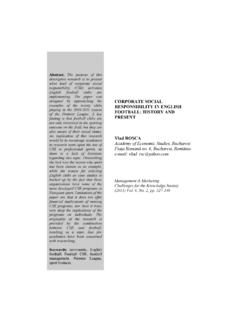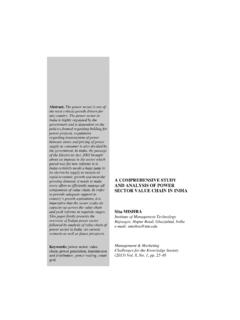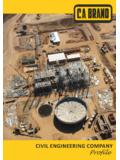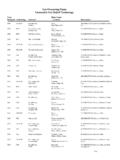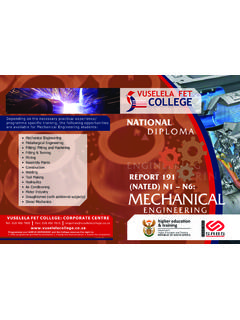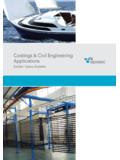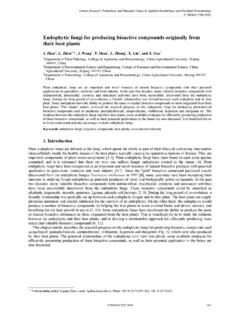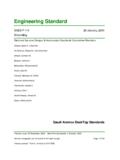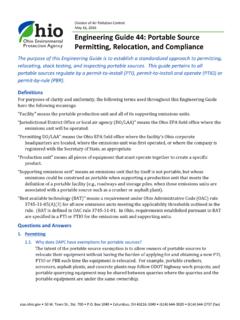Transcription of STRUCTURAL ANALYSIS OF ENGINEERING …
1 Abstract. Strategic management models have been evolving in the business domain on a continuous basis but the overwhelming majority of works in this field gives the impression that it is only the manufacturing industry that needs strategy and strategic models, or that the strategy in the professional services industry is the same as in the manufacturing industry despite their distinctive characteristics and managerial implications. By using the Porter s Five Forces framework for industry ANALYSIS , which evaluates a certain industry based on five parameters each focusing on different challenges a company can potentially face with, the paper aims at analyzing the strategic landscape of ENGINEERING consulting and design companies.
2 The purpose of this paper is to discuss an interpretation and adaptation of Porter s Five Forces model to professional services industry, and in particular to ENGINEERING consulting and design industry. Keywords: professional services firms (PSFs), industry ANALYSIS , ENGINEERING consulting and design companies (ECDCs). STRUCTURAL ANALYSIS OF ENGINEERING consulting AND DESIGN INDUSTRY Gabriel Sorin STROE UZINSIDER ENGINEERING Gala i 2, Sm rdan Street, Gala i, Rom nia e-mail: Management & Marketing Challenges for the Knowledge Society (2013) Vol.
3 8, No. 1, pp. 41-62 Management & Marketing 421. Introduction Strategic management models have been evolving on a continuous basis since the late nineteenth century but the overwhelming majority of works in this field gives the impression that there are only the manufacturing or services industries that need strategy and strategic models, or that the strategy in the professional services industry ( Professional ENGINEERING consulting and Design Services) is the same as in the manufacturing industry despite their distinctive characteristics, managerial implications and organizational responses.
4 By using the classic framework for industry ANALYSIS known as Porter s Five Forces, which evaluates a certain industry based on five parameters, the paper aims at analyzing the general and most common competitive landscape and adapting Porter s model for the case of the ENGINEERING consulting and Design Industry. The ENGINEERING consulting and design, although it is a niche industry, cannot be viewed in isolation since the industry s structure and trends are influenced by a wider range of stakeholders, encompassing clients, higher education institutions, supply industries, professional and trade associations.
5 The ANALYSIS in this report is supported by the general literature on Professional Services Firms (PSFs), scarce literature on ENGINEERING firms, also by author s own practicing experience of more than 20 years in the consulting and ENGINEERING design industry, both as a design engineer also as a general manager of an ENGINEERING company. The ANALYSIS can be characterized as a descriptive one, starting with a general overview of the ENGINEERING consulting and design industry, containing a literature survey on the specific characteristics of ENGINEERING consulting and Design Companies ECDCs (common with those of PSFs)
6 And a description and classification of the ENGINEERING consulting and design services, and then continuing with an introduction of Porter s Five Forces framework adapted for the specific case of ENGINEERING consulting and design industry. The paper ends up with a set of conclusions and managerial implications, also with a set of proposed directions for further research on the industry. 2. ENGINEERING consulting and design industry a general overview Within the Professional Services Firms (PSFs) sector, ENGINEERING consulting and design companies (ECDCs) are among the least studied entities (Rimmer, 1991).
7 However, in the international management literature there can be found some books and papers approaching narrow and distinct directions of study such as characterization of consulting and ENGINEERING design organizations in developing countries (Ar oz, 1981; Malhotra, 1976; Kamenetzky, 1976), exploratory empirical study of the international consulting ENGINEERING design services industry from an perspective (Stanbury, 1992), strategic management in ENGINEERING organizations (Chinowsky and Meredith, 2000; Chinowsky, 2001.)
8 Veshosky, 1994), operational STRUCTURAL ANALYSIS of ENGINEERING consulting and design industry 43strategy, flexibility and performance (Aranda, 2003), knowledge creation and management (Baark, 2002), pricing of ENGINEERING services (Farr, 2001; Stasiowsky, 1993; Sturts and Griffis, 2005), product design (Hales and Gooch, 2004; Reinertsen, 1997), costs control ENGINEERING design organizations (Pellicer, 2005), marketing practices and strategies of ENGINEERING design firms (Jaafar et al.
9 , 2008; Maliti, 2010; Shearer, 1990), critical success factors (Koutsikouri, 2006), impact of diversity, experience, compensation of human capital on firm performance (Laursen et al., 2005), relationship between intellectual capital and business performance (Huang and Hsueh, 2007), and the learning process during customer relationship (Salmi et al., 2005). The ECDCs, among others of the same knowledge-based and professional type, are worthy of attention since they played and are still playing an important role in the economic growth of countries in the world today.
10 That they have been unnoticed so far is probably because they are so obscure, small and hidden in statistics as services or, in the best case, as professional services companies. As ECDCs belong to the PSFs category which in its turn is a sub-group of the Knowledge-Intensive Firms (KIFs) or Know-How Companies group, the following mutual characteristics of these types of companies relevant for the present ANALYSIS are presented (L wendahl, 2005; Sveiby and Lloyd, 1987; Alvesson, 1995, 2004; Scott, 1998): Their business consists in creative, complex, and customized problem-solving.
